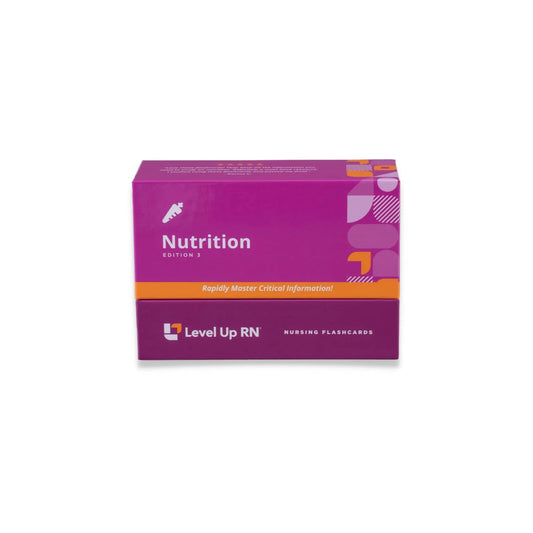When you see this Cool Chicken, that indicates one of Cathy's silly mnemonics to help you remember. The Cool Chicken hints in these articles are just a taste of what's available across our Level Up RN Flashcards for nursing students!
In this article, we cover these key electrolytes: calcium, magnesium, phosphorus, potassium, and sodium. We also cover dietary sources for these electrolytes as well as what it means when these levels are too low or too high in the body.
This series follows along with our Nutrition Essentials for Nursing Flashcards which are intended to help RN and PN nursing students study for nursing school exams, including the ATI, HESI, and NCLEX.
Nutrition Essentials - Nursing Flashcards
Nutrition plays a key role in patient wellness, and patient teaching regarding nutrition is a key part of EVERY nurse's job. These flashcards will help you understand the basics of nutrition, along with key nutritional and lifestyle considerations for common health disorders.
Calcium (Ca)
Calcium is an electrolyte that is critical for bone and teeth formation, muscle and nerve function, as well as clotting. The normal range for calcium is between 9 - 10.5 mEq/L.
Calcium sources
Key dietary sources of calcium include dairy products such as milk, yogurt, cheese, kale, broccoli, fish like sardines and salmon, and fortified foods like cereal.
Hypercalcemia
Hypercalcemia is a calcium level that is too high (greater than 10.5 mEq/L), and it can cause constipation, kidney stones, bone pain, muscle weakness, and confusion.
Hypocalcemia
Hypocalcemia is a calcium level that is too low (less than 9 mEq/L), and it can cause positive Chvostek’s and Trousseau’s signs, muscle spasms, and paresthesia which is a burning, prickling sensation ("pins and needles").
Magnesium (Mg)
Magnesium is is an electrolyte that is critical for nerve and muscle function as well as many biochemical reactions in the body. The normal range for magnesium is between 1.3 - 2.1 mEq/L
Magnesium sources
Dietary sources of magnesium include nuts, seeds, legumes, whole grains, green leafy vegetables, milk, yogurt, and fortified cereal.
Hypermagnesemia
Hypermagnesemia is a magnesium level that is too high (greater than 2.1 mEq/L), and it can cause lethargy, muscle weakness, decreased deep tendon reflexes, as well as respiratory depression and cardiac arrest.
Hypomagnesemia
Hypomagnesemia is a magnesium level that is too low (less than 1.3 mEq/L), and it can cause tremors, increased deep tendon reflexes, as well as dysrhythmias like Torsades de pointes, tachycardia, hypertension and seizures.
Phosphorus (P)
Phosphorus is an electrolyte that is essential for bone and teeth mineralization, cell structure, as well as energy production. The normal range for phosphorus is between 3 - 4.5 mg/dL.
Phosphorus sources
Dietary sources of phosphorus include dairy products such as milk, yogurt, and cheese, as well as fish, poultry, eggs, and legumes.
Phosphorus and calcium relationship
One key thing to note about phosphorus is that it has an inverse relationship with calcium. So if calcium levels are high, phosphorus levels will be low. If calcium levels are low, phosphorus levels will be high.
Hyperphosphatemia
Hyperphosphatemia is the term for phosphorus levels that are too high (greater than 4.5 mg/dL), and it will result in signs and symptoms of hypocalcemia, including muscle spasms.
Hypophosphatemia
Hypophosphatemia is the term for phosphorus levels that are too low (less than 3 mg/dL), and it will result in signs and symptoms of hypercalcemia such as bone pain, muscle weakness, and confusion.
Potassium (K)
Potassium is an electrolyte that is essential for the maintenance of intracellular fluid, as well as the regulation of muscle and heart contractions.
The normal range for potassium is between 3.5 and 5 mEq/L
Potassium sources
Dietary sources of potassium include fruits such as bananas, apricots, orange juice, cantaloupe, and tomatoes, as well as vegetables such as potatoes, spinach, and broccoli. Other dietary sources include legumes, milk, and salt substitutes.
Hyperkalemia
Hyperkalemia is a potassium level that is too high (greater than 5 mEq/L), and this can cause dysrhythmias.
Hypokalemia
Hypokalemia is a potassium level that is too low (less than 3.5 mEq/L), and this can cause dysrhythmias. This is frequently tested on in nursing school.
Sodium (Na)
Sodium is an electrolyte that is essential for nerve and muscle function as well as fluid volume maintenance.
The normal range for sodium is between 136 and 145 mEq/L.
Sodium sources
Dietary sources of sodium include shellfish, meat, table salt, processed foods, and frozen foods.
Hypernatremia
Hypernatremia is a sodium level that is too high (greater than 145 mEq/L), and it can cause thirst, lethargy, confusion, GI upset, muscle twitching, seizures, and irritability/agitation.
Hyponatremia
Hyponatremia is a sodium level that is too low (less than 136 mEq/L), and it can cause confusion (which is a common finding in elderly patients with low sodium), fatigue, headaches, nausea and vomiting, and seizures.


